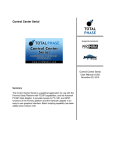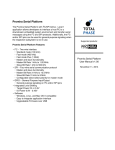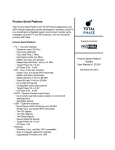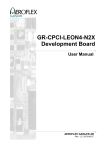Download Flash Socket Board Pro User Manual v1.00
Transcript
Flash SOIC-8 Socket Board - 10/34
Supported products:
Flash SOIC-16 Socket Board - 10/34
Flash Socket Boards - 10/34
User Manual v1.00
November 17, 2014
Summary
The Flash Socket Boards allow a developer to flash and burn
stand-alone SPI Serial Flash memory chips by using
Promira™ Serial Platform with I2C/SPI Active - Level 1
application, Cheetah™ SPI Host Adapter or Aardvark™ I2C/
SPI Host Adapter as an interface from a Windows or Linux
computer. The Flash SOIC-8 Socket Board - 10/34 supports
SOIC-8 and SOIC-8W chip packages. The Flash SOIC-16
Socket Board - 10/34 supports the SOIC-16 chip package.
Flash Socket Board Pro User Manual
1 Overview
The Flash Socket Boards provide embedded systems engineers with an easy and costeffective method of programming SPI Serial Flash memory chips. Using Total Phase's
industry-leading Promira™ Serial Platform with I2C/SPI Active - Level 1 application,
Cheetah™ SPI Host Adapter or Aardvark I2C/SPI Host Adapter, engineers can take full
advantage of the Flash Center™ programming software to program their SPI Serial
Flash memory chips.
1.1 Features
• Flash and burn SPI Serial Flash chips that have a standard pinout and are in any
of these standard chip packages: SOIC-8, SOIC-8W, or SOIC-16
• Provide to target device 0.9 V - 5 V power supply from the adapter or external
power source
• Gang-program multiple devices by using multiple socket board and programming
adapter sets in parallel on the same host computer.
1.2 What's Included
The Flash SOIC-8 Socket Board - 10/34 and Flash SOIC-16 Socket Board - 10/34 are
sold separately.
1.3 Flash Center Software
The Flash Center Software is a free software package that allows engineers to quickly
erase, program, and verify SPI Serial Flash memory chips that are interfaced through a
Promira Serial Platform, Cheetah SPI Host Adapter or Aardvark I2C/SPI Host Adapter.
2
Flash Socket Board Pro User Manual
Figure 1 : Flash Center Software
1.3.1 Features
• Fast speeds programing.
• Gang programming support – the Flash Center Software can program multiple
devices in parallel by connecting to multiple Promira Serial Platforms, Cheetah
SPI Host Adapters, and/or Aardvark I2C/SPI Host Adapters on the same
computer.
• Extensible device support – the Flash Center Software has an extensible XMLbased memory device library. By adding or modifying the XML descriptions of
target memory devices, developers can instantly support almost any I2C- or SPIbased EEPROM or Serial Flash memory.
1.3.2 Minimum Requirements
• Windows or Linux (64 or 32 bit)
◦ Windows: Windows 7, Windows 8, Windows 8.1
◦ Linux: Red Hat, SuSE, Ubuntu, Fedora
• One or more available high-speed USB 2.0 ports
• One or more Promira Serial Platforms, Cheetah SPI Host Adapters and/or
Aardvark I2C/SPI Host Adapters
1.4 Promira Serial Platform
The Promira Serial Platform with I2C/SPI Active - Level 1 application is an I2C/SPI
adapter that is capable of communicating over I2C from 1 KHz to 1.02/0.5 MHz and over
SPI from 31 KHz to 12.5/8 MHz in master/slave mode. The Promira platform is designed
to communicate with I2C/SPI based EEPROM and Flash memories. It is a convenient
tool to develop, prototype, debug, and program {{i2c}/SPI based systems.
3
Flash Socket Board Pro User Manual
Figure 2 : Promira Serial Platform
1.4.1 Features
• I2C Master/Slave signaling from 1 KHz to 1.02/0.5 MHz
• Master/Slave SPI signaling from 31 KHz to 12.5/8 MHz
• Built-in voltage level shifter
• General Purpose I/O
• Windows and Linux support
• Free software and royalty-free API
1.5 Cheetah SPI Host Adapter
The Cheetah SPI Host Adapter is a high-speed SPI adapter that is capable of
communicating over SPI from 100 KHz to 40+ MHz. The Cheetah adapter is specifically
designed to communicate with high-speed, SPI-based Flash memory. It is an ideal tool
to develop, debug, and program SPI-based systems.
4
Flash Socket Board Pro User Manual
Figure 3 : Cheetah SPI Host Adapter
1.5.1 Features
• SPI Master signaling from 100 KHz to 40+ MHz
• Maximum throughput with no inter-byte delays
• User-configurable timing delays
• Windows and Linux support
• Free software and royalty-free API
1.6 Aardvark I2C/SPI Host Adapter
The Aardvark I2C/SPI Host Adapter is an I2C/SPI adapter that is capable of
communicating over I2C from 1 KHz to 800 KHz and over SPI from 125/100 KHz to 8/4
MHz (master/slave mode). The Aardvark adapter is designed to communicate with I2C/
SPI based EEPROM and Flash memories. It is a convenient tool to develop, prototype,
debug, and program I2C/SPI based systems.
5
Flash Socket Board Pro User Manual
Figure 4 : Aardvark I2C/SPI Host Adapter
1.6.1 Features
• I2C Master/Slave signaling from 1 KHz to 800 KHz
• SPI Master/Slave signaling from 125/100 KHz to 8/4 MHz
• General Purpose I/O
• Windows and Linux support
• Free software and royalty-free API
6
Flash Socket Board Pro User Manual
2 Sockets
The Flash Socket Boards offer different sockets to interface with your memory chip.
Figure 5 : The Flash SOIC-8 Socket Board - 10/34 provides
SOIC-8 (150mil) and SOIC-8W (200mil) sockets for
interfacing with your stand-alone memory chip.
Figure 6 : The Flash SOIC-16 Socket Board - 10/34
provides a SOIC-16 socket for interfacing with your standalone memory chip.
Please note that each socket has its own dedicated 34-pin boxed header for connecting
Promira Serial Platform, and 10-pin boxed header for connecting Cheetah SPI Host
Adapter or Aardvark I2C/SPI Host Adapter.
7
Flash Socket Board Pro User Manual
2.1 Compatible Chip Sizes
The sockets of the Flash Socket Boards are with standard sized chip packages. Figure 7
provides information about the supported sizes for all the sockets. Please note that all
measurements are in millimeters (mm).
Figure 7 : Diagrams of the supported package sizes.
Please note that the diagrams are not to scale.
Compatible chip sizes for each of the sockets available on the Flash Socket Boards. All
measurements are in millimeters (mm).
SOIC-8W SOIC-8 SOIC-16
Pitch
(P)
1.27
1.27
1.27
Thickness
(A)
1.90
1.90
1.90
Lead Tip to Tip Width
(E)
8.00
6.00
10.40
Molded Package Width (E1)
5.23
3.90
7.50
Overall Length
5.23
5.40
10.50
(D)
8
Flash Socket Board Pro User Manual
2.2 Pinouts
The sockets of the Flash Socket Boards are compatible with standard SPI Serial Flash
chip pinout configurations. Each socket is labeled with the specific pinout. Please verify
that the Serial Flash memory chip that is to be programmed is compatible with the
pinouts as seen in Figure 8 and Figure 9.
On the Flash Socket Boards, VDD is nominally 0.9 V - 5 V and the HOLD and WP lines
are tied to VDD through a weak pull-up resistor.
Figure 8 : Pinouts for the SOIC-8 and SOIC-8W sockets on
the Flash SOIC-8 Socket Board - 10/34.
Figure 9 : Pinout for the SOIC-16 socket on the Flash
SOIC-16 Socket Board - 10/34.
If your Serial Flash memory chip has a non-standard pinout configuration, please
consider using the EEPROM Socket Board - 10/34. It is possible to arbitrarily assign
signals to different pins with this board using its 8-pin split cable.
9
Flash Socket Board Pro User Manual
3 Connectors
3.1 34-pin Boxed Connector and 10-pin Boxed Connector
The sockets are connected to 34-pin boxed connector and to 10-pin boxed connector
which are located directly beneath it. The 34-pin boxed connector is used to connect the
sockets to Promira Serial Platform to program the target device. The 10-pin boxed
connector is used to connect the sockets to Cheetah SPI Host Adapter or Aardvark I2C/
SPI Host Adapter to program the target device.
The connectors' HOLD and WP signals are pulled-up to VDD.
VDD Selector Connector
The VDD selector connector (JP1) has 3 jumpers options, which configured the power
source to the memory: 3.3V, VTgt, and VLvl. To select one of these voltages, simply use
a jumper to short the pins next to the appropriate voltage on the VDD selector connector
• 3.3V – The power voltage to the memory is 3.3V. The target power pins of the
Promira platform, Cheetah adapter, or Aardvark adapter supply 5V to the board
voltage regulator.
• VTgt – The power voltage to the memory is 3.3 V or 5V, which is supplied directly
from the target power pins of the Promira platform, Cheetah adapter, or Aardvark
adapter.
• VLvl – The power voltage to the memory is 0.9 V - 3.45 V, which is supplied
directly from the I/O power pins of the Promira platform.
• No Jumpers – The power voltage to the memory is from external 0.9 V - 5 V
power supply that is connected to the VDD Selector connector (JP1) pins 2, 4, or
6.
Powering the Flash Socket Boards
The Flash Socket Boards provide 0.9 V - 5 V to the target device from the adapter or
from external source. If the power source to the Flash Socket Boards is the adapter, then
the Promira platform, Cheetah adapter or the Aardvark adapter must be configured to
send target power to the board. This can be accomplished via the Rosetta Language
Bindings, the Flash Center software, the Control Center Software or the Cheetah GUI
Software. When powered-on, the board's Power LED will be lit.
10
Flash Socket Board Pro User Manual
4 Programming a Device
SPI Serial Flash memory can be programmed using the Flash Center Software in
conjunction with Promira platform, Cheetah adapter or Aardvark adapter. Detailed
technical information about all these products can be found on Total Phase's website.
4.1 Inserting a Device
To program a chip, insert the chip into the appropriate socket.
Whenever handling chips, always be sure to follow safe handling procedures to ensure
that the chips are not damaged.
All sockets are zero insertion force sockets and work on the same principle.
To insert a chip:
1. Press down on the top of the socket to raise the contact pins.
2. While pressing down on the socket, carefully place the chip into the socket and
make sure that the orientation of the chip is correct (pin 1 should always be in the
top left corner).
3. Once the chip is in place, release the top of the socket to allow the contact pins to
drop and hold the chip in place.
At this point, the chip should be held securely in place. Please make sure that all the
contact pins have made contact with the correct pins on the chip.
Removing a Device
When removing the chip, we recommend using a vacuum pickup tool to prevent damage
to the chip and its pins.
To remove a chip:
1. Press down on the top of the socket to raise the contact pins.
2. Carefully remove the chip using a vacuum pickup tool or equivalent tool.
11
Flash Socket Board Pro User Manual
3. Release the top of the socket.
4.2 Powering the Device
To configure the power source to the memory, select one of the three voltage options
(3.3V, VTgt, and VLvl) on the VDD selector connector (JP1).
4.3 Supported Vendors
The Flash Socket Boards support SPI Serial Flash memory from these leading
manufacturers:
• Atmel
• Chingis
• Intel
• Macronix
• Numonyx/ST Micro
• Spansion
• SST
• Winbond
• Micron
SPI Serial Flash memory chips from other vendors may also be supported as long as
they conform to the standard pinout as described in the previous sections.
12
Flash Socket Board Pro User Manual
5 Legal / Contact
5.1 Disclaimer
All of the software and documentation provided in this manual, is copyright Total Phase,
Inc. ("Total Phase"). License is granted to the user to freely use and distribute the
software and documentation in complete and unaltered form, provided that the purpose
is to use or evaluate Total Phase products. Distribution rights do not include public
posting or mirroring on Internet websites. Only a link to the Total Phase download area
can be provided on such public websites.
Total Phase shall in no event be liable to any party for direct, indirect, special, general,
incidental, or consequential damages arising from the use of its site, the software or
documentation downloaded from its site, or any derivative works thereof, even if Total
Phase or distributors have been advised of the possibility of such damage. The software,
its documentation, and any derivative works is provided on an "as-is" basis, and thus
comes with absolutely no warranty, either express or implied. This disclaimer includes,
but is not limited to, implied warranties of merchantability, fitness for any particular
purpose, and non-infringement. Total Phase and distributors have no obligation to
provide maintenance, support, or updates.
Information in this document is subject to change without notice and should not be
construed as a commitment by Total Phase. While the information contained herein is
believed to be accurate, Total Phase assumes no responsibility for any errors and/or
omissions that may appear in this document.
5.2 Life Support Equipment Policy
Total Phase products are not authorized for use in life support devices or systems. Life
support devices or systems include, but are not limited to, surgical implants, medical
systems, and other safety-critical systems in which failure of a Total Phase product could
cause personal injury or loss of life. Should a Total Phase product be used in such an
unauthorized manner, Buyer agrees to indemnify and hold harmless Total Phase, its
officers, employees, affiliates, and distributors from any and all claims arising from such
use, even if such claim alleges that Total Phase was negligent in the design or
manufacture of its product.
5.3 Contact Information
Total Phase can be found on the Internet at http://www.totalphase.com/. If you have
support-related questions, please submit a support request at https://
www.totalphase.com/support. For sales inquiries, please contact [email protected].
13
Flash Socket Board Pro User Manual
©2010-2014 Total Phase, Inc.
All rights reserved.
14























